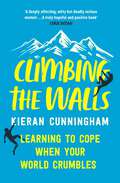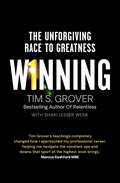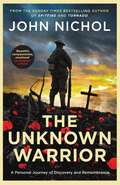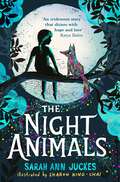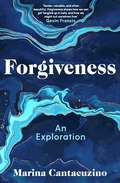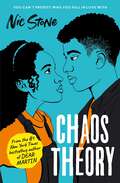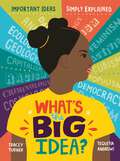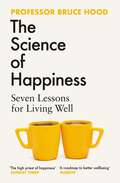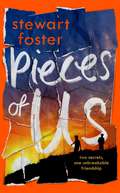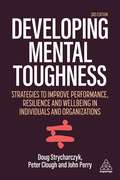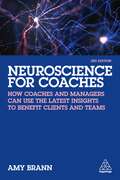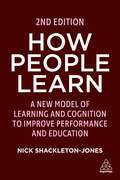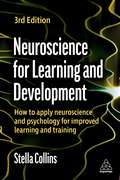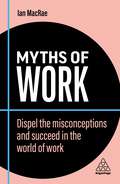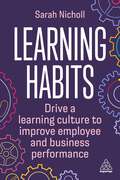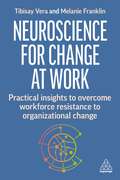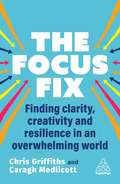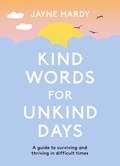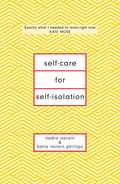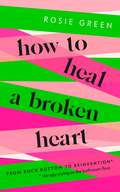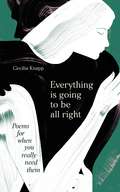- Table View
- List View
Climbing the Walls
by Kieran CunninghamWhen mountains are your salvation, what keep your mental weather calm and free of storms, how do you cope if they&’re out of reach? After spending a decade restlessly globetrotting in search of a way of life that worked for him, journalist Kieran Cunningham alighted on Sondrio, a small town in Lombardy, Italy. A stone&’s throw from the Alps, there he found the perfect combination of fresh mountain air, a strong network of local friends and lots of climbing. Finally he was able to accept and manage his diagnosis of Bipolar 1. And then Lombardy found itself the European epicentre of Covid-19 and subject to the strictest of lockdowns. What does a climber do when his beloved peaks are off limits? When he&’s only permitted to leave the house for his weekly sanctioned grocery shop? When all the things that help him maintain his delicate equilibrium are taken away? As Kieran feels his mental health begin to crumble, he looks desperately for something he can climb to help rid him of his excess energy and hopefully get him back on track. Kieran finds himself navigating the walls of his house over and over while gazing at the mountain ranges so tantalisingly close. He dreams of that first euphoric climb – alone in the clouds, tired, happy, sated. Climbing the Walls is a memoir about mental health and the power of nature and exercise. It&’s both a devastatingly honest account of living with Bipolar 1 and a love song to small-town Italian life and the high places that keep him healthy.
When I Come Home Again: A beautiful and heartbreaking WWI novel, based on true events
by Caroline Scott**From the highly acclaimed author of The Photographer of the Lost, a BBC Radio 2 Book Club Pick** &‘A superb and quietly devastating novel about grief, hope and the horrific aftershocks of war&’ The Times, Book of the MonthThey need him to remember. He wants to forget. 1918. In the last week of the First World War, a uniformed soldier is arrested in Durham Cathedral. When questioned, it becomes clear he has no memory of who he is or how he came to be there. The soldier is given the name Adam and transferred to a rehabilitation home. His doctor James is determined to recover who this man once was. But Adam doesn&’t want to remember. Unwilling to relive the trauma of war, Adam has locked his memory away, seemingly for good. When a newspaper publishes a feature about Adam, three women come forward, each claiming that he is someone she lost in the war. But does he believe any of these women? Or is there another family out there waiting for him to come home?Based on true events, When I Come Home Again is a deeply moving and powerful story of a nation&’s outpouring of grief, and the search for hope in the aftermath of war. Praise for When I Come Home Again: 'Breathtaking exploration of loss, love and precious memories&’ My Weekly, Pick of the Month &‘A heartbreaking read which reveals the far-reaching tragedies of war… I highly recommend it&’ Anita Frank &‘Caroline Scott&’s quietly devastating second novel insightfully explores the impact of the Great War on returning soldiers and their families' S Magazine &‘A powerful story that&’s achingly moving and most beautifully written. Readers of Maggie O&’Farrell and Helen Dunmore are likely to enjoy&’ Rachel Hore &‘Powerful… A carefully, nuanced, complex story&’ Woman & Home 'This beautiful and moving book drew me in from the first line and held me enthralled until the very end' Fiona Falpy &‘An evocative read&’heat 'A compulsive, heart-wrenching read' Liz Trenow &‘Scott litters her tale with clues and red herrings in the best mystery-writer way so we are kept guessing as to where the truth really lies&’ The BookBag 'Page turning, mysterious, engrossing and compelling' Lorna Cook &‘Caroline Scott evokes the damage and desolation of the Great War with aching authenticity' Iona Grey 'Wonderful and evocative' Suzanne Goldring &‘A beautifully written novel – immersive, poignant, intricately woven&’ Judith Kinghorn &‘The story left me breathless. Powerful, heartrending, and oh so tender. A whirlwind of emotions that will not allow us to forget&’ Kate Furnivall
Winning: The Unforgiving Race to Greatness (Tim Grover Winning Ser.)
by Shari Wenk Tim S. Grover&‘Tim Grover&’s teachings completely changed how I approached my professional career, helping me navigate the constant ups and downs that sport at the highest level brings.&’ Marcus Rashford, MBEFrom the elite performance coach for Michael Jordan, Kobe Bryant, Dwyane Wade and many others - and the author of the powerful bestseller Relentless - a no-holds-barred formula for winning that is ideal for business people, athletes and anybody wanting to achieve success. In Relentless, Tim Grover showed that you need to be tough and ruthless - towards others and yourself - to achieve your goals. Now, in Winning he takes that skill repertoire to an even higher level, demonstrating why he is one of the world&’s most sought-after mindset experts. Based on three decades of work with elite competitors like Michael Jordan, Kobe Bryant and Dwyane Wade, Winning challenges you to destroy every obstacle in your path, even if, at the moment of greatest triumph, it may be all taken away. Whether you&’re an athlete striving to win, an entrepreneur building a business, a CEO managing an empire, a salesperson looking to close a deal, or a high achiever determined to stand in the winner&’s circle, Winning offers thirteen key principles for ramping up your performance to the maximum. If you&’re addicted to the taste of success and crave more, then you&’re ready for the results-driven performance formula found here. And if you&’re already winning and want to learn how to execute excellence repeatedly - so you can own not just this moment, but the next, and the next - then Winning is for you.
The Unknown Warrior: A Personal Journey of Discovery and Remembrance
by John Nichol&‘Compelling… [Nichol has a] terrific eye for detail; an ability to blend tear-jerking letters, quotation and personal anecdotes into a rich, thought-provoking narrative&’Daily Telegraph Over one million British Empire soldiers were killed during the First World War. More than a century later, over half a million still have no known grave. The scale of the fighting, the catastrophic destruction, the relentless military engagement and glutinous mud meant that many of the dead were never identified, of often, never recovered. Names were left without bodies, and bodies, or fragments of bodies, without names. To help staunch the tide of national grief in the aftermath of the conflict, an idea was born for a single 'Unknown Warrior' representing all the missing, to be brought from the battlefields and buried in Westminster Abbey alongside the nation's kings and queens. Using diaries, archives and interviews with the descendants of that generation and modern-day experts, Sunday Times bestselling author and former RAF Tornado navigator John Nichol draws on his own experience of combat and loss to shine light on this 100-year-old story. And in speaking to those who have lost loved ones in more modern conflicts, he examines our continuing need for a tangible resting place at which to truly grieve the fallen. His search for answers becomes a moving and personal journey, exploring the true meaning of camaraderie, service, sacrifice and remembrance.
The Night Animals
by Sarah Ann JuckesUncover the ghost animals within in this moving and uplifting story about finding help where you need it, from the highly acclaimed author and illustrator of The Hunt for the Nightingale. Nora's mum has good days and bad days, but the bad days are getting worse. It's been just the two of them for always, and they don't need anyone else. When the rainbow-shimmering ghost animals Nora used to see when she was small start to reappear, she's convinced that they hold all the answers. Along with new friend Kwame, Nora follows a glittering ghostly fox, hare, raven and otter on the adventure of a lifetime, helping her to find the strength she needs to help her family. In a heartbreaking and hopeful narrative, Sarah Ann Juckes' stunning novel, illustrated by the award-winning Sharon King-Chai sees a brave young girl face down her ghosts. For fans of The Last Bear and Julia and the Shark. Praise for Hunt for the Nightingale &‘Full of hope, beauty & ultimately a healing song to nature' Hannah Gold, author of The Last Bear 'An incredibly moving story of feeling lost and finding your way again' Lisa Thompson, author of Rollercoaster Boy 'Will break your heart and mend it back together again' Piers Torday, author of The Last Wild 'This poignant exploration of grief and denial seen through the eyes of a child is underpinned by lessons about kindness, acceptance and nature&’ Daily Mail
Forgiveness: An Exploration
by Marina CantacuzinoI forgive you. Three simple words behind which sits an intriguing and complex concept. These words can be used to absolve a meaningless squabble, or said to someone who has caused you great harm. They can liberate you from guilt, or consciously place blame on your shoulders. Forgiveness can often be perceived as saccharine and overtly religious, something just for the spiritually superior or mentally strong. But really it is a gritty, risky concept that is so often relevant to our ordinary everyday lives. Forgiveness explores the subject from every angle, coming from a place of enquiry rather than persuasion, presenting it as an offering, never a prescription. Marina Cantacuzino seeks to investigate, unpick and debate the limits and possibilities of forgiveness – in our relationships, for our physical and mental wellbeing, how it plays out in international politics and within the criminal justice system, and where it intersects with religious faith. Cantacuzino speaks to people across the globe who have considered forgiveness in different forms and circumstances. She talks to a survivor of Auschwitz; to someone who accidentally killed a friend; to people who have lost loved ones in acts of violence; to a former combatant in The Troubles as well as to the daughter of someone he murdered. Through these real stories, expert opinion and the author&’s experience from two decades working in this field, the reader gets to better understand what forgiveness is and what it most definitely isn&’t, how it can be an important element in breaking the cycle of suffering, and ultimately how it might help transform fractured relationships and mend broken hearts.
Chaos Theory: The brand-new novel from the bestselling author of Dear Martin
by Nic StoneThe #1 New York Times bestselling author of Dear Martin delivers a gripping romance about two teens: a certified genius living with a diagnosed mental illness and a politician's son who is running from his own addiction and grief. Don't miss this gut punch of a novel about mental illness, loss, and discovering you are worthy of love. The next read for fans of Angie Thomas, Danielle Jawando and Jason ReynoldsScars exist to remind us of what we&’ve survived . . . Since Shelbi enrolled at Windward Academy as a senior and won&’t be there very long, she hasn&’t bothered making friends. What her classmates don&’t know about her can&’t be used to hurt her – you know, like it did at her last school. Andy Criddle is not okay. At all. He&’s had far too much to drink. Again. Which is bad. And things are about to get worse. When Shelbi sees Andy at his lowest, she can relate. So she doesn&’t resist reaching out. And there&’s no doubt their connection has them both seeing stars . . . but the closer they get, the more the past threatens to pull their universes apart. #1 New York Times bestselling author Nic Stone delivers a tour de force about living with grief, prioritizing mental health, and finding love amid the chaos. Praise for Dear Martin: "Powerful, wrenching" John Green "A must-read" Angie Thomas "Raw and Gripping" Jason Reynolds "Deeply moving" Jodi Picoult Also by Nic Stone:Dear Martin Odd One Out JackpotDear Justyce
One True Loves: A Novel
by Taylor Jenkins ReidFrom the New York Times bestselling author of The Seven Husbands of Evelyn HugoNamed a Best Book of Summer by Cosmopolitan * InStyle *PopSugar * Buzzfeed * Bustle * Brit+Co * Parade&“No one does life and love better.&” InStyle &“Earth-shaking…you will flip for this epic love story.&” Cosmopolitan In her twenties, Emma Blair marries her high school sweetheart, Jesse. They build a life for themselves, far away from the expectations of their parents and the people of their hometown in Massachusetts. They travel the world together, living life to the fullest and seizing every opportunity for adventure. On their first wedding anniversary, Jesse is on a helicopter over the Pacific when it goes missing. Just like that, Jesse is gone forever. Emma quits her job and moves home in an effort to put her life back together. Years later, now in her thirties, Emma runs into an old friend, Sam, and finds herself falling in love again. When Emma and Sam get engaged, it feels like Emma&’s second chance at happiness. That is, until Jesse is found. He&’s alive, and he&’s been trying all these years to come home to her. With a husband and a fiance, Emma has to now figure out who she is and what she wants while trying to protect the ones she loves. But who is her one true love? What does it mean to love truly?
What's the Big Idea?
by Tracey TurnerHave you ever wondered what capitalism is? How about feminism, ecology, epidemiology or astronomy? Well, this book will give you straightforward, easy-to-understand answers to all your troublesome-word questions WITHOUT going on and on for ages OR using even BIGGER words to explain them. Informative, bite-sized explanations alongside beautiful, eye-catching illustrations will help readers aged 8+ understand crucial concepts, giving them the power to take part in the most important conversations on the planet. Perfect for inquisitive minds, this book will appeal to fans of Goodnight Stories for Rebel Girls, Big Ideas for Curious Minds and beyond.More than 100 big words and ideas, simply explained.
The Science of Happiness: Seven Lessons for Living Well
by Bruce Hood&‘Do yourself a favour and grab this fantastic guide! Explains practical strategies for getting out of our own heads and finding more connection, presence, and joy&’ LAURIE SANTOS, Professor of Psychology at Yale University and host of The Happiness Lab podcast _______________________________________________________________________We all want to be happier, but our brains often get in the way. When we&’re too stuck in our heads we obsess over our inadequacies, compare ourselves with others and fail to see the good in our lives.In The Science of Happiness, world-leading psychologist and happiness expert Bruce Hood demonstrates that the key to happiness is not self-care but connection. He presents seven simple but life-changing lessons to break negative thought patterns and re-connect with the things that really matter. Alter Your Ego Avoid Isolation Reject Negative Comparisons Become More Optimistic Control Your Attention Connect With Others Get Out of Your Own Head Grounded in decades of studies in neuroscience and developmental psychology, this book tells a radical new story about the roots of wellbeing and the obstacles that lie in our path. With clear, practical takeaways throughout, Professor Hood demonstrates how we can all harness the findings of this science to re-wire our thinking and transform our lives. _______________________________________________________________________&‘The Science of Happiness is a rare bird – a book that is grounded in the best new science, written with wit and wisdom, and provides clear and valuable lessons for living your best life. Highly recommended!&’ DANIEL GILBERT, author of the New York Times bestseller Stumbling on Happiness&‘This is a wonderful guide to what actually makes people happier – full of wisdom backed by a wealth of scientific evidence. If you want practical ideas that you can use right now to boost your wellbeing, this is your book&’ ROBERT WALDINGER, author of The Good Life: Lessons from the World's Longest Study on Happiness&‘The most erudite, thoughtful, and original take on this important subject I have ever encountered. I learned something new in every chapter, and as a bonus it&’s a page-turning read' MICHAEL SHERMER, author of Why People Believe Weird Things
Pieces of Us
by Stewart FosterTwo secrets, an unbreakable bond . . . a powerful and heartbreaking love letter to a life-changing friendship, from award-winning author, Stewart Foster. I wish you were here, because maybe this isn&’t a story, or a diary. Perhaps it&’s just the longest thank you letter a friend could ever write. As the summer before college begins, Jonas is hiding a secret. He suffers with bulimia, but no one knows. Not even he knows how bad it really is. Until he meets Louis, a confident dreamer who believes in a better future for Jonas and together they enjoy a sun-kissed summer filled with music, memories and life-changing moments. But when tragedy strikes, Jonas must decide if he has the strength to face things alone . . . Writing from personal experience, an award-winning author shines an important light on difficult themes of illness, mental health, and grief in a redemptive story of friendship, for readers of Meg Rosoff and Sarah Crossan. Warning: contains some themes that readers may find upsetting, including disordered eating.
Developing Mental Toughness: Strategies to Improve Performance, Resilience and Wellbeing in Individuals and Organizations
by John Perry Peter Clough Doug StrycharczykHow can individuals and organizations understand and measure mental toughness to deal with stress and challenge, and so improve performance? This fully updated third edition of Developing Mental Toughness provides the answers to unlock this potential.Tracing its development from sports psychology into the business sector, Developing Mental Toughness provides a reliable psychometric measure to apply at the organizational level. With coverage on how mental toughness relates to other behaviours and can be applied to employability, leadership, performance, creativity, emotional intelligence and motivation, the practical guidance and exercises in this book make it essential reading for academics, managers and coaches alike.This third edition includes an expansion of the 4Cs model to include concepts on learning orientation and resilience and new chapters on evidence-based practice and using the Mental Toughness Questionnaire (MTQ48) to gain richer self-awareness. Featuring case studies from Deloitte and Ethiad, Developing Mental Toughness is the practical coaching guide for developing capabilities and resilience.
Neuroscience for Coaches: How coaches and managers can use the latest insights to benefit clients and teams
by Amy BrannMany coaching tools and techniques are now well established, but how do they actually work? The third edition of Neuroscience for Coaches answers this question to help coaches and managers deliver greater value to clients and employees.Based on extensive research, Neuroscience for Coaches provides a clear explanation of the aspects of neuroscience that are relevant to coaching so coaches can describe to clients why particular techniques work and the benefits to be gained from using them. It also features interviews with Marshall Goldsmith, Susan Grandfield, Christian van Nieuwerburgh and Kim Morgan on topics including mindfulness and behaviour change in coaching.This fully updated third edition covers the latest neuroscientific research on key brain areas and their functions, such as the Prefrontal cortex and Amygdala which affect attention, processing and emotional regulation. With tips and insights throughout, it crucially demonstrates the ways in which coaches and managers who coach can use this information effectively and practically in their everyday work. Neuroscience for Coaches is a vital resource for improving coaching practice with the latest scientific developments, tools and techniques.
How People Learn: A New Model of Learning and Cognition to Improve Performance and Education
by Nick Shackleton-JonesHow can I design training so that it makes a real difference to employees' skills and development? This book gives L&D professionals everything they need to build effective learning experiences.How People Learn provides L&D professionals a new way of thinking about learning by exploring what happens when we learn. It shows how to apply insights from neuroscience, human behaviour and artificial intelligence (AI) to learning design including tips on how to interest, excite and engage staff in training. Using the author's '5Di model', this book demonstrates how to define, design and deploy training into existing workflows so it works both for and with employees. It also explores how simulations can be used to replicate a real-world challenge as closely as possible.The second edition features new material on learning in a hybrid world, and how to manage skills development and performance now that work, workplaces and workers have changed. It includes more practical guidance on building programmes with user-centred design and covers developments in the connection between learning and cognition, alongside case studies and examples from companies such as BP and the BBC.
Neuroscience for Learning and Development: How to Apply Neuroscience and Psychology for Improved Learning and Training
by Stella CollinsNeuroscience for Learning and Development provides L&D professionals the tools and ideas to design and deliver effective initiatives with knowledge of how our brains process information.Using the latest research and concepts, this book covers areas such as motivation, habits and the link between sleep and learning. It demonstrates how to create effective learning environments and make learning 'stickier' with advancements in AI and digital learning, and through the use of stories. The practical tools and guidance can be applied in different contexts, such as digital learning, in-person training sessions and presentations.The third edition contains a new chapter on creating an autonomous learning culture. It explains the strategies, tools and techniques L&D professionals can use to encourage and support employees to learn in the flow of work. With insights from L&D practitioners who have applied these approaches in organizations such as The Open University, this edition is an indispensable book for creating and maintaining workplace learning that benefits people and organizations.
Myths of Work: Dispel the Misconceptions and Succeed in the World of Work (Business Myths)
by Ian MacRaeBuying a table tennis table will make your staff happier. Working eight hours a day, five days a week, will result in the most productivity. Paying higher salaries will always result in higher motivation. But will it really?There are a staggering number of myths, stereotypes and out-of-date rules that abound in the workplace. This can make it feel impossible to truly know how to get the most out of your career, your team and your company. In Myths of Work, Ian MacRae take an entertaining and evidence-based look at the most pervasive myths about our working lives, from the serious to the ridiculous, to give you the insight you need to become a better manager in the modern workplace. Fascinating real life case studies from organizations around the world display the myths (and how to overcome them) in practice.Myths of Work combines business thinking with psychology to give you practical insights, a lively writing style and a handy dip-in-and-out structure to form your ultimate guide to becoming a better and enlightened manager.About the Business Myths series...The Business Myths series tackles the falsehoods that pervade the business world. From leadership and management to social media and the workplace, these accessible books overturn out-of-date assumptions, skewer stereotypes and put oft-repeated slogans to the myth-busting test. Both entertaining and rigorously researched, these books will equip you with the insight and no-nonsense wisdom you need to succeed.
Learning Habits: Drive a Learning Culture to Improve Employee and Business Performance
by Sarah NichollA learning culture is essential to outperform the competition but how can Learning and Development (L&D) professionals achieve this? What habits do they need to develop in their workforce? Learning Habits is written by an author with over 20 years' experience using learning science to improve both business and employee outcomes. It explains what habits are necessary for an effective learning culture and how to develop them at individual, team and organizational levels. This book outlines each habit, explains what it is, why it makes a difference and how to measure it as well as providing a framework that can be used to make these habits become routine to ensure the learning sticks. Each habit is underpinned by behavioural science research and supported by practical advice, real world examples and case studies from global organizations. Learning Habits also includes checklists to track progress, a 'cue, routine, reward, reflect' model to make learning habits core to how the business operates and templates for measurement. This book is essential reading for all L&D practitioners who know that building a learning culture is crucial for individual and business success but don't know where to start.
Neuroscience for Change at Work: Practical Insights to Overcome Workforce Resistance to Organizational Change
by Melanie Franklin Tibisay VeraHow do I communicate change to the business? How do I maintain productivity and wellbeing during change? How do I deal with resistance to business change?Neuroscience for Change at Work answers these questions and explains how to use insights from neuroscience when designing change and communicating it to employees. It is based on the PEPE model which outlines the four fundamental principles that drive resistance to change in individuals, teams and the wider organization. This book provides specific coverage of how neuroscience can inform change initiatives in remote, hybrid and in-person working environments to ensure successful business transformation in any working model. There is also discussion of how change can impact employee mental health and wellbeing and explains how using insights from neuroscience can help to safeguard this. There is also discussion of how to handle competing priorities from different groups of employees during times of business change. Every chapter of Neuroscience for Change at Work is supported by practical examples, tips, tools and case studies as well as robust, evidence-based insights from neuroscience. Co-authored by a neuroscientist with extensive experience in applying neuroscience to business transformation projects, this book is a practical guide for all change managers and anyone responsible for employee engagement, wellbeing and productivity during times of change.
The Focus Fix: Finding Clarity, Creativity and Resilience in an Overwhelming World
by Chris Griffiths Caragh MedlicottWith focus and a clear mind, we can achieve almost anything. But we are constantly subjected to a deluge of distractions, from endless notification pings to anxiety and self-doubt.The Focus Fix explores how you can reset your mindset in order to reclaim your focus and achieve incredible results. In this fascinating book, leading creativity expert Chris Griffiths and journalist Caragh Medlicott unearth scientific studies and inspiring case studies to offer practical and proven techniques that will allow you to dispel distractions and maintain your focus.This book also uncovers the numerous benefits of sustained focus: you can achieve more by doing less, improve your mental wellbeing and boost your creativity. Don't get distracted - maximize your potential and discover the antidote to burnout with The Focus Fix.
The Kindness Club on Mapleberry Lane
by Helen Rolfe'A warm, comforting tale of family and community which brims with kindness and love' Annie Lyons'A heartwarming story about family, forgiveness and the importance of kindness... If you're looking for a feelgood novel in these difficult times, this is definitely it!' Fiona HarperThe smallest things can make the biggest difference...Veronica Beecham's cottage is the neatest house on Mapleberry Lane. A place for everything, and everything in its place - that's her motto. But within her wisteria-covered walls, Veronica has a secret: she's hardly left her perfect home in years.Then her teenage granddaughter, Audrey, arrives on the doorstep, and Veronica's orderly life is turned upside down. Shy and lonely, Audrey is struggling to find her place in the world. As a bond begins to form between the two women, Audrey develops a plan to give her gran the courage to reconnect with the community - they'll form a kindness club, with one generous action a day to help someone in the village, and perhaps help each other at the same time. As their small acts of kindness begins to ripple outwards, both Veronica and Audrey find that with each passing day, they feel a little braver. There's just one task left before the end of the year: to make Veronica's own secret wish come true...A heartwarming story with community at its heart, about the little kindnesses that make the world a better place. Perfect for fans of Cathy Bramley and Holly Hepburn!***Readers adore Helen's heartwarming storytelling'Enchanting... Employing all the warmth and charm of Maeve Binchy, and a special brand of kindness that she has made her own, Rolfe weaves together elements of mystery, romance, family relationships and the warmth of community in a story guaranteed to bring laughter, tears and miles of smiles' Lancashire Post'A lovely community, full of friendship and love''I enjoyed every minute of this book and found it very hard to put down''Lovely, feel-good...filled with lots of love''Gave you all the emotions: suspense, happiness and excitement''Helen Rolfe's writing brought a smile to my face''Loved loved loved this fabulous book''Full of wonderful characters, great food, a lovely location'
Kind Words for Unkind Days: A Guide To Surviving And Thriving In Difficult Times
by Jayne HardyA practical pick-me-up for life’s tough days, this book is the perfect guide to help you feel happier, healthier and calmer.
Self-Care for Self-Isolation: The perfect self help book for lockdown
by Nadia Narain Katia Narain Phillips'Exactly what I needed to read right now.' Kate Moss'I love this little book and think it's the most practical guide to surviving lockdown I have come across so far. it's accessible, kind and practical. Everyone can help themselves and others by reading it!' Emma Thompson'Love the sound of 'the daily promise jar'. There's something useful and hopeful for everyone in here.' Melissa Hemsley'The tonic I needed in this unsettled time. It helped me feel that I wasn't alone but also gave me so many lovely achievable tips to get me through these days. I want to print out so much of it and put it on my walls for inspiration.' Lisa Faulkner'Uplifting, practical and so reassuring to read.' Jools OliverWhen we wrote our first book about self-care, we talked about how looking after yourself helped you to ride the waves of everyday life. But a lot has changed since then, in ways none of us could have predicted. And some of the waves got way bigger.Self-care might feel like the last thing on your mind in the middle of social distancing and self-isolation. And yet looking after ourselves, and our health, has never been more important. Self-care sisters and bestselling authors Nadia and Katia have found their own practices challenged by lockdown and staying at home. Here they offer their practical, non-preachy thoughts on how to get through this period with your sanity intact.Self-Care for Self-Isolation is full of exercises, recipes, and essential techniques for dealing with the financial and emotional fallout of a global pandemic, and offers hope and inspiration for the future.'Think Marie Kondo for the mind, if you will, or the Hemsleys for the soul,' Sunday Times
How to Heal a Broken Heart: From Rock Bottom to Reinvention (via ugly crying on the bathroom floor)
by Rosie Green'The poster girl for divorce.' The Times'If you've ever had your heart broken (and who hasn't) Rosie Green's How to Heal a Broken Heart is your best friend. Honest, comforting and hopeful.' MARIAN KEYES'I love Rosie Green's writing.' ELIZABETH DAY'Brilliant. One of the few books that I've found that really describes what a broken heart feels like. It touched so many nerves.' VANESSA FELTZ'It reduced me to tears.' EMMA BARNETT, Woman's Hour, BBC Radio 4'It wasn't a conscious uncoupling. I had my heart ripped out and stamped on.'When Rosie Green's husband walked out after 26 years together, he declined to leave a forwarding address. Instead, he left a devastated woman who turned into someone she barely recognised: unable to eat or sleep, and so desperate to keep her family together she'd sacrifice her sense of self - and her dignity.She thought she'd never get over it. But she did. And so can you. This is the frank, uplifting and insightful book Rosie wished she could have found when her whole world fell apart. Here's your guide to getting through it - with advice from the experts, with the help of your friends, with a deliciously dark sense of humour and, for Rosie, with some highly inappropriate sex advice from her pre-teen daughter. Let her brilliantly honest handbook show how you can heal faster, understand yourself better and move on.How to Heal a Broken Heart doesn't sugarcoat it - heartbreak brings you to your knees. But, sometimes, it also gives you a necessary shove towards a happier, more fulfilled life than you ever dreamed was possible.
Everything is Going to be All Right: Poems for When You Really Need Them
by VariousFrom grief to toothache, heartbreak to homesickness, the power of finding solace in the words of another cannot be overstated.Whether it was written 300 years ago or in our present day, poetry provides a comforting light in the dark. Words may not always provide solutions, but they can at the very least offer us a sense of hope, and the reassurance that we are not alone in our experiences and in our feelings.The Poetry First Aid Kit is a ready-made toolkit that offers you a light in the dark, no matter what you are feeling. Comprising poems from literary classics to new, cutting edge voices writing about the world today, this extraordinary collection proves that we are never alone in the suffering we endure, and in the human spirit's capacity to overcome.Whether you are well-versed in poetry or sceptical to the power it holds, we hope that this collection will surprise you, entertain, and ultimately offer comfort through those difficult days.Featuring poems from: Kae Tempest, Hollie McNish, Raymond Antrobus, Salena Godden, Theresa Lola, Maya Angelou, Emily Dickinson and many, many more.
Everything is Going to be All Right: Poems for When You Really Need Them
by VariousFrom grief to toothache, heartbreak to homesickness, the power of finding solace in the words of another cannot be overstated.Whether it was written 300 years ago or in our present day, poetry provides a comforting light in the dark. Words may not always provide solutions, but they can at the very least offer us a sense of hope, and the reassurance that we are not alone in our experiences and in our feelings.The Poetry First Aid Kit is a ready-made toolkit that offers you a light in the dark, no matter what you are feeling. Comprising poems from literary classics to new, cutting edge voices writing about the world today, this extraordinary collection proves that we are never alone in the suffering we endure, and in the human spirit's capacity to overcome.Whether you are well-versed in poetry or sceptical to the power it holds, we hope that this collection will surprise you, entertain, and ultimately offer comfort through those difficult days.Featuring poems from: Kae Tempest, Hollie McNish, Raymond Antrobus, Salena Godden, Theresa Lola, Maya Angelou, Emily Dickinson and many, many more.
